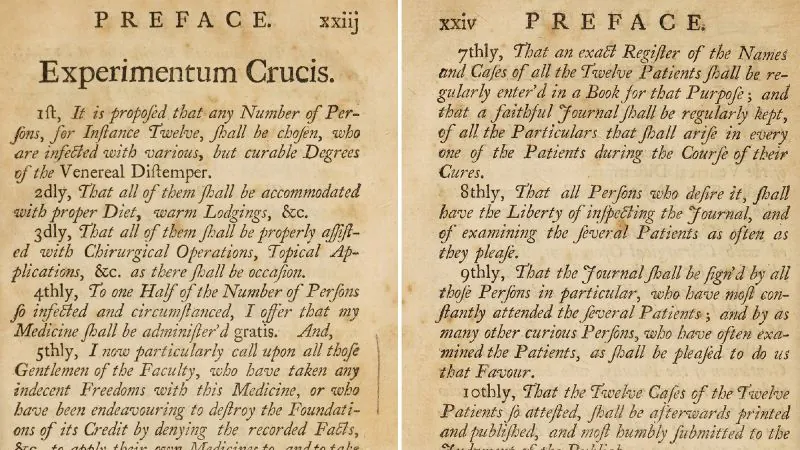
Unveiling the Hidden Legacy of 18th Century Trials: How Francis Hauksbee's Proposal May Have Paved the Way for Modern Medicine
2025-01-18
Author: Ming
Introduction
In a remarkable twist of history, a fresh analysis reveals that a little-known 18th-century figure, Francis Hauksbee the Younger, may have influenced the landmark clinical trial conducted by James Lind in 1747, which identified the cure for scurvy. This research, published in Notes and Records: The Royal Society Journal of the History of Science, sheds light on the early development of clinical trials—most notably their significance in transforming medical research from anecdotal evidence to systematic, controlled experiments.
James Lind's Groundbreaking Trial
James Lind, a surgeon in the Royal Navy, conducted the first controlled clinical trial by testing the effectiveness of various treatments for scurvy aboard the HMS Salisbury. In a historical context, scurvy had plagued sailors for centuries, leading to enormous loss of life on long maritime voyages. Lind's trial was groundbreaking; he divided 12 affected sailors into pairs and assigned each group different treatments, ultimately discovering that oranges and lemons dramatically improved the sailors’ health.
Francis Hauksbee's Proposal
However, new insights suggest that Lind's pioneering work might have been sparked by Hauksbee’s 1743 proposal for a systematic approach to test treatments for venereal disease. Hauksbee, an instrument maker and scientific lecturer, outlined a 10-step research design that aimed to rigorously assess various medications, calling his plan "Experimentum Crucis," or "decisive experiment." He advocated for a scientifically-minded evaluation of treatments, a progressive notion for his time.
Hauksbee's Influence and Challenges
Though Hauksbee wasn’t a physician and faced skepticism from the medical establishment, his meticulous methodology included comparing his treatment with others and documenting the patients’ outcomes. This kind of analytical approach was hardly the norm among his contemporaries, who often promoted their medicines without substantial evidence.
The Medical Establishment's Resistance
Despite the historical significance of Hauksbee’s work, there is no evidence that his proposed study was ever actually conducted, primarily due to the resistance from the established medical community of the time. Physicians were typically reluctant to adopt treatments from non-licensed practitioners, viewing Hauksbee as a quack rather than an innovator.
The Shift with Lind's Findings
The research trajectory changed dramatically with Lind’s trial that followed just four years later, which marked the beginning of modern clinical research as we know it. Lind’s findings laid the groundwork for future advancements, and his structured approach was instrumental in elevating the standards of medical testing.
Evolution of Clinical Trials
The article points out that the evolution of clinical trials—where treatments are compared based on outcomes—has roots in these early experiments. Modern clinical trials are far more rigorous and ethical than those of the 18th century, where patients often didn’t have the choice to refuse participation, nor were they fully informed about their involvement in trials.
Implications for Modern Medicine
Dr. Max Cooper, the lead author of the recent study, emphasizes that understanding these historical foundations can enrich medical education today. By studying the trial proposals and approaches of early practitioners like Hauksbee and Lind, modern physicians can gain valuable insights into the development of rigorous research methodologies.
Conclusion
In this light, the exploration of Hauksbee's work is not just a mere footnote in medical history; it marks a critical juncture in how treatments were evaluated, forever changing the landscape of clinical medicine. This fascinating narrative illustrates that the evolution of clinical trials wasn't solely the result of formal physicians but also included the contributions of unconventional thinkers who dared to challenge the status quo. As we look back at these pioneering efforts, it’s clear that the principles of critical assessment and rigorous testing take precedence in the quest for effective treatments—lessons that remain vital to this day.

 Brasil (PT)
Brasil (PT)
 Canada (EN)
Canada (EN)
 Chile (ES)
Chile (ES)
 Česko (CS)
Česko (CS)
 대한민국 (KO)
대한민국 (KO)
 España (ES)
España (ES)
 France (FR)
France (FR)
 Hong Kong (EN)
Hong Kong (EN)
 Italia (IT)
Italia (IT)
 日本 (JA)
日本 (JA)
 Magyarország (HU)
Magyarország (HU)
 Norge (NO)
Norge (NO)
 Polska (PL)
Polska (PL)
 Schweiz (DE)
Schweiz (DE)
 Singapore (EN)
Singapore (EN)
 Sverige (SV)
Sverige (SV)
 Suomi (FI)
Suomi (FI)
 Türkiye (TR)
Türkiye (TR)
 الإمارات العربية المتحدة (AR)
الإمارات العربية المتحدة (AR)